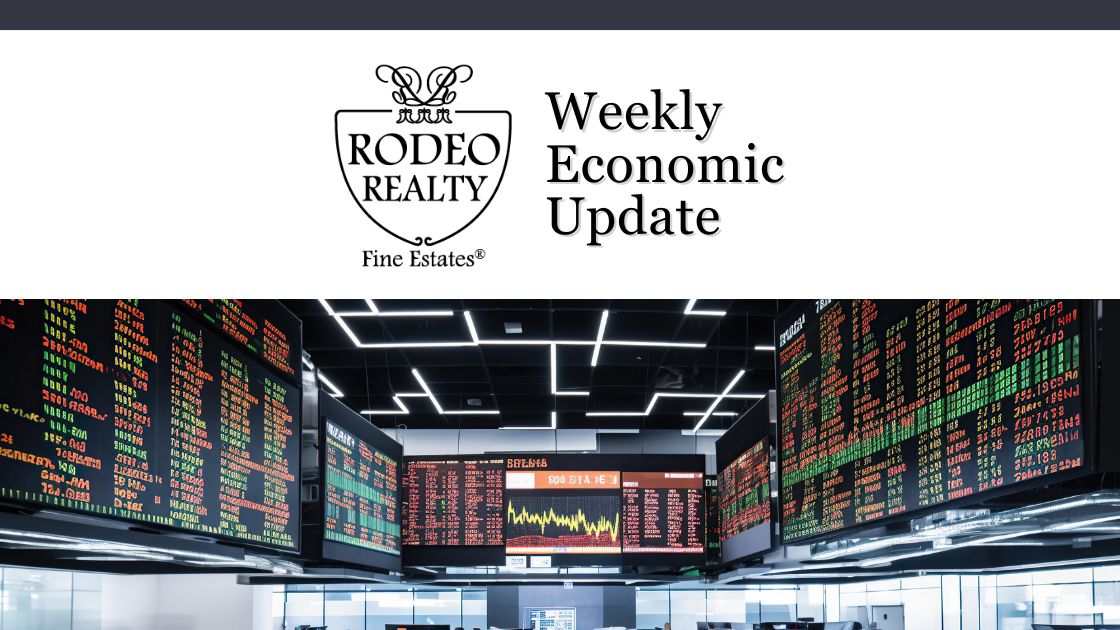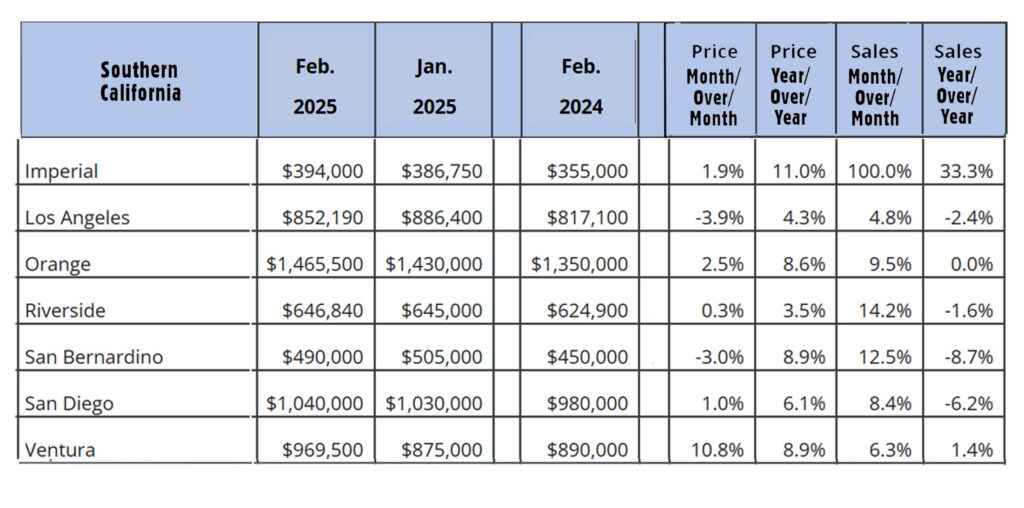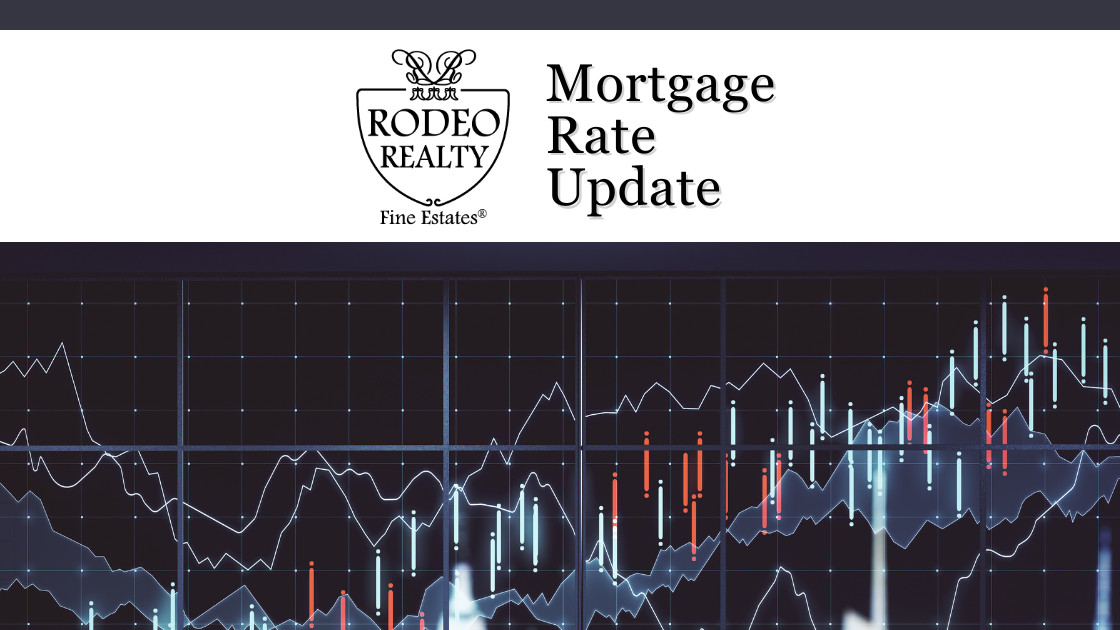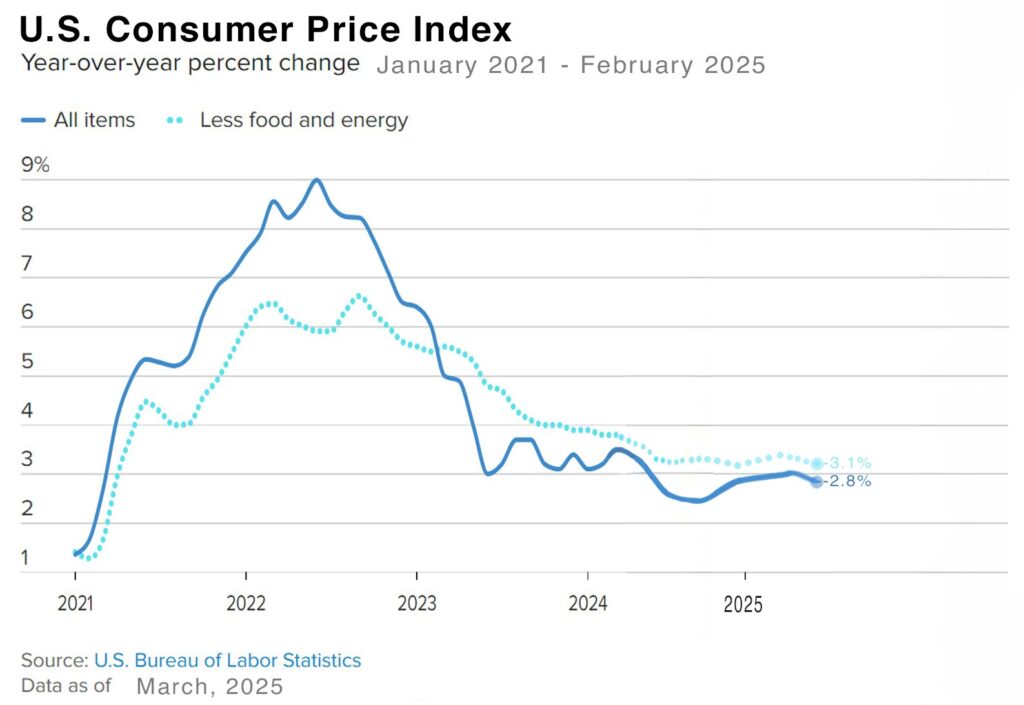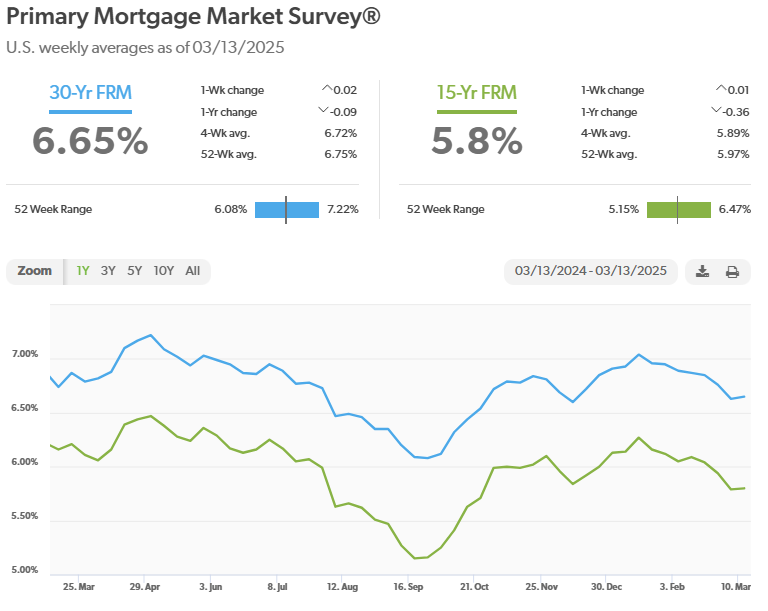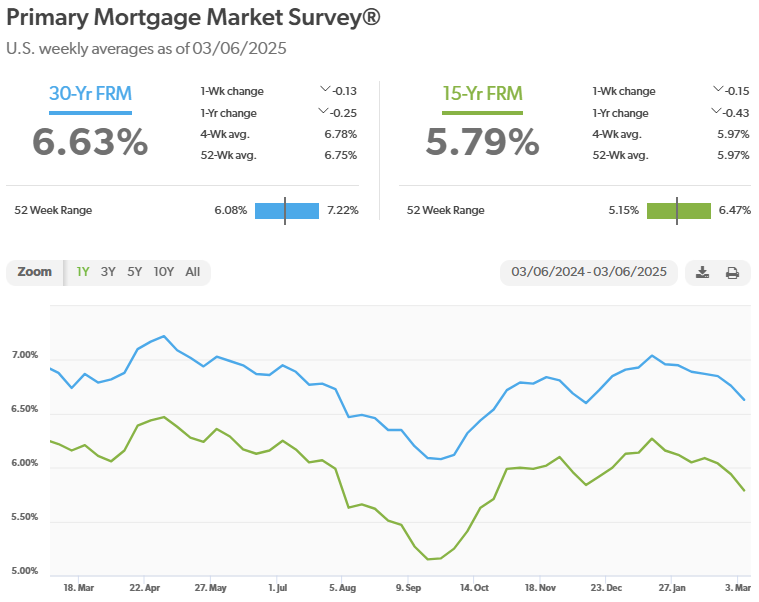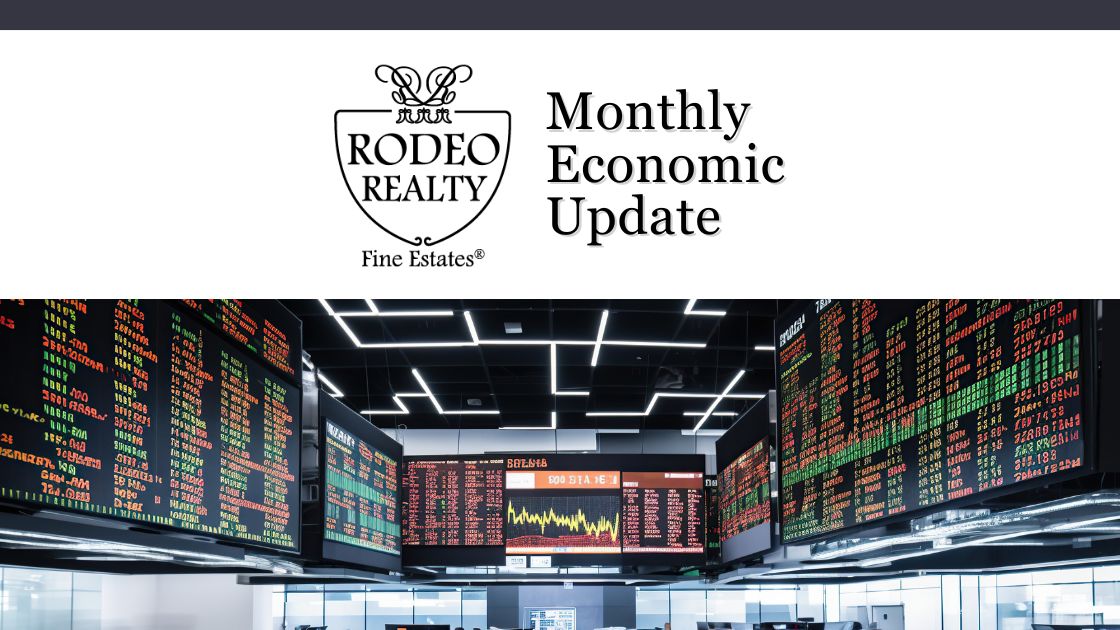| This week the Federal Reserve met to discuss monetary policy. On Wednesday they issued their monetary policy statement. While they left interest rates unchanged, they said that they are going to pause reducing their balance sheet in April. That means that the Fed will halt its sales of the treasury bond securities that they own. One of the ways that they brought long-term rates down during COVID and the financial crisis was to purchase treasury bonds and mortgage securities. Over the past three years, they have been selling those assets to reduce their balance sheet. By halting those sales there will be fewer treasury bonds on the market which should drive yields and long-term interest rates lower. Bond yields and mortgage rates have dropped since the Fed made the announcement on Wednesday.
Stock markets -The Dow Jones Industrial Average closed the week at 41,985.35, up 1.2% from 41,488.19 last week. It is down 1.3% year-to-date. The S&P 500 closed the week at 5,667.56, up 0.5% from 5,638.94 last week. The S&P is down 3.6% year-to-date. The Nasdaq closed the week at 17,784.05, up 0.2% from 17,754.09 last week. It is down 7.9% year-to-date. U.S. Treasury bond yields The 10-year treasury bond closed the week yielding 4.25%, down from 4.31% last week. The 30-year treasury bond yield ended the week at 4.59%, down from 4.62% last week. We watch bond yields because mortgage rates follow bond yields. Mortgage rates – Every Thursday Freddie Mac publishes interest rates based on a survey of mortgage lenders throughout the week. The Freddie Mac Primary Mortgage Survey reported that mortgage rates for the most popular loan products as of March 20, 2025, were as follows: The 30-year fixed mortgage rate was 6.67%, up slightly from 6.65% last week. The 15-year fixed was 5.83%, up slightly from 5.80% last week. Rates ended the week lower after the Fed announced that they were going to pause reducing their balance sheet on Wednesday. The graph below shows the trajectory of mortgage rates over the past year.
Home sales data is released on the third week of the month for the previous month by the California Association of Realtors and the National Association of Realtors. These are February’s home sales figures. U.S. existing-home sales February 2025 – The National Association of Realtors reported that existing-home sales totaled 4.26-million units on a seasonal annualized rate in February, up 1.2% from an annualized rate of 4-million units last February. The median price for a home sold in the U.S. in February was $398,400 up 3.8% from $383,800 one year ago. There was a 3.5-month supply of homes for sale in February, up from a 3-month supply one year ago. First-time buyers accounted for 31% of all sales. Investors and second-home purchases accounted for 16% of all sales. All cash purchases accounted for 32% of all sales. Foreclosures and short sales accounted for 3% of all sales. California existing-home sales – The California Association of Realtors reported that existing-home sales totaled 283,540 on an annualized basis in February, up 11.6% month-over-month from 254,110 homes sold on an annualized basis in January, and up 2.6% year-over-year from a revised 278,280 homes sold on an annualized basis. The statewide median price paid for a home in was $829,060 in February, up 2.8% from $806,480 one year ago. There was a 4-month supply of homes for sale in January, up from a 2.9-month supply of homes for sale last February. The graph below lists home sales data by county in Southern California.
Have a Great Weekend! |
Mortgage Rate Update | March 20, 2025
Mortgage rates – Every Thursday Freddie Mac publishes interest rates based on a survey of mortgage lenders throughout the week. The Freddie Mac Primary Mortgage Survey reported that mortgage rates for the most popular loan products as of March 20, 2025, were as follows:
The 30-year fixed mortgage rate was 6.67%, up slightly from 6.65% last week. The 15-year fixed was 5.83%, up slightly from 5.8% last week.
The graph below shows the trajectory of mortgage rates over the past year.
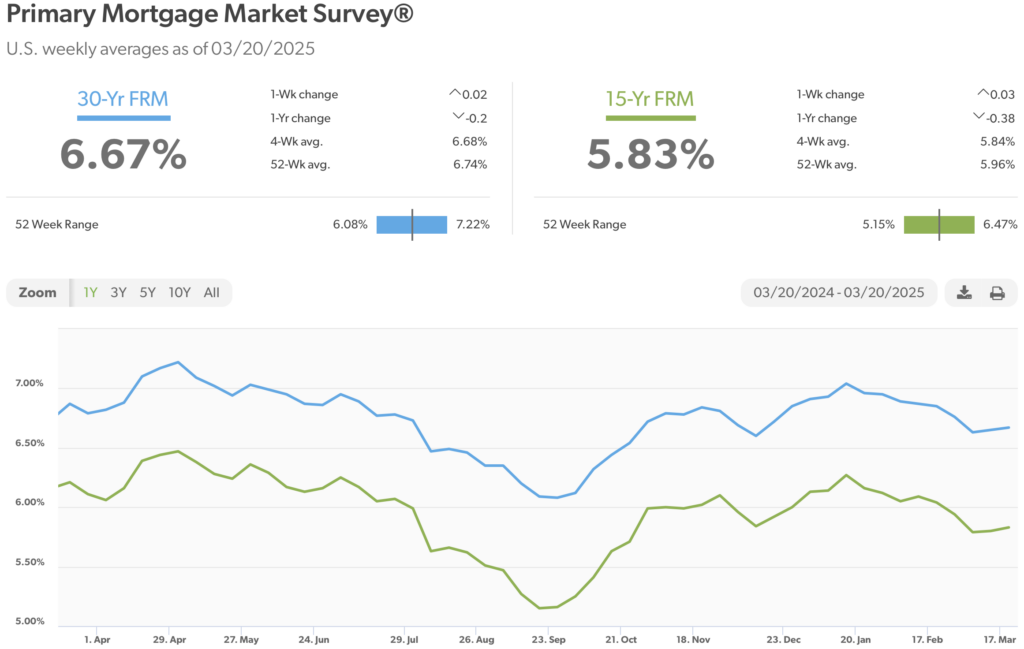
Freddie Mac was chartered by Congress in 1970 to keep money flowing to mortgage lenders in support of homeownership and rental housing. Their mandate is to provide liquidity, stability, and affordability to the U.S.
Economic Update | Week Ending March 15, 2025
| Inflation eased in February – The Consumer Price Index (CPI) rose 2.8% in February from one year earlier, down from a year-over-year increase of 3% in January. The CPI rate had increased steadily since hitting a 3 ½ year low of 2.4% in September until February. Perhaps it will continue to tick down. Core CPI, which excludes volatile food and energy prices, rose 3.1% year-over-year, down from a 3.3% annual rate in January. That marked the smallest yearly increase in Core CPI since April 2021. The Producer Price Index (PPI) rose 3.2% from one year earlier, down sharply from a 3.7% year-over-year increase in January. The PPI gauges wholesale inflation which is considered an indicator of future consumer inflation as wholesale costs are often passed on to consumers.
U.S. Treasury bond yields – Usually when stock markets drop investors rush to the safety of treasury bonds and yields fall. Additionally, when inflation drops bond yields and mortgage rates drop as well. That did not happen in the last two weeks because investors are worried that tariff costs will be passed along to consumers and inflation will reignite. The 10-year treasury bond closed the week yielding 4.31%, unchanged from 4.32% last week. The 30-year treasury bond yield ended the week at 4.62%, unchanged from 4.62% last week. We watch bond yields because mortgage rates follow bond yields. Mortgage rates – Every Thursday Freddie Mac publishes interest rates based on a survey of mortgage lenders throughout the week. The Freddie Mac Primary Mortgage Survey reported that mortgage rates for the most popular loan products as of March 13, 2025, were as follows: The 30-year fixed mortgage rate was 6.65%, almost unchanged from 6.63% last week. The 15-year fixed was 5.8%, unchanged from 5.79% last week. The graph below shows the trajectory of mortgage rates over the past year.
Have a Great Weekend! |
If you’d like to unsubscribe and stop receiving these emails click here .
Mortgage Rate Update | March 13, 2025
Mortgage rates – Every Thursday Freddie Mac publishes interest rates based on a survey of mortgage lenders throughout the week. The Freddie Mac Primary Mortgage Survey reported that mortgage rates for the most popular loan products as of March 13, 2025, were as follows:
The 30-year fixed mortgage rate was 6.65%, up from 6.63% last week. The 15-year fixed was 5.8%, up from 5.79% last week.
The graph below shows the trajectory of mortgage rates over the past year.
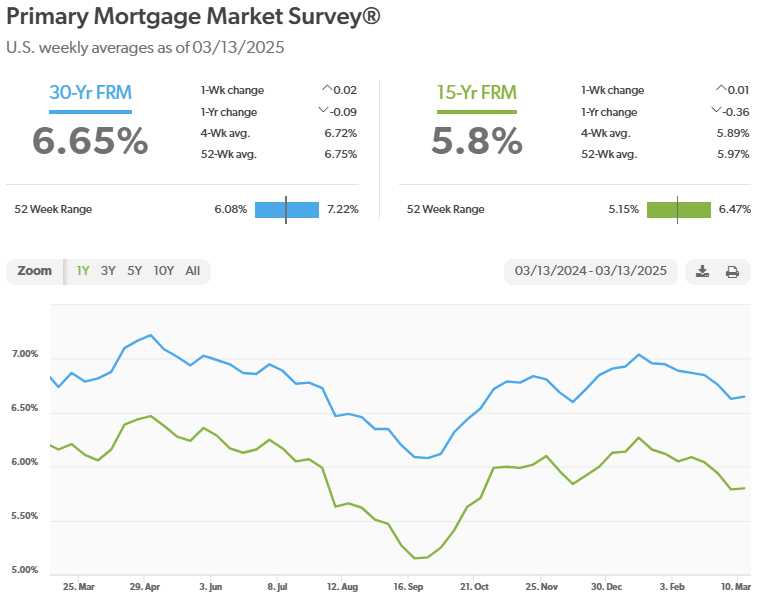
Freddie Mac was chartered by Congress in 1970 to keep money flowing to mortgage lenders in support of homeownership and rental housing. Their mandate is to provide liquidity, stability, and affordability to the U.S.
Economic Update | Week Ending March 8, 2025
| Economic highlights this week – It was a volatile week on Wall Street, bond markets, and mortgage markets. Stocks ended the week sharply lower despite rebounding slightly on Friday. The volatility centered around the Trump Administration’s tariffs. A 25% tariff on imports from Canada and Mexico and a 20% tariff on imports from China went into effect on Tuesday. On Wednesday some of the tariffs, like automobiles from Canada, the U.S.’s largest trading partner were postponed for a month. There were also comments from Treasury Sectary, Scott Bessent, and others in the administration that suggested that these tariffs would not last long while comments from President Trump suggested that more tariffs are coming. All in all, it was a confusing week that left investors and corporations uncertain on what was ahead. It is difficult for businesses to plan when they do not know what the future holds for tariffs. Uncertainty caused fear and the stock markets dropped sharply this week. Bond yields and mortgage rates also fluctuated this week as investors wondered if the tariffs could cause a recession which would raise the unemployment rate, slow the economy, curtail consumer spending, and lower inflation, or if tariffs would just make everything more expensive and boost inflation.
151,000 new jobs were added in February – The Department of Labor and Statistics reported that 151,000 new jobs were added in February, up from a revised 125,000 new jobs added in January. While that was below the 160,000 economists had forecasted, the government shed 10,000 jobs, so 161,000 non-government jobs were added. The unemployment rate ticked up to 4.1%, from 4% in January. It was 4.1% in December. Average hourly wages increased 4% in February from one year ago, down slightly from a 4.1% annual increase in January. Stock markets – The Dow Jones Industrial Average closed the week at 42,801.72, down 2.4% from 43,840.91 last week. It is up 0.6% year-to-date. The S&P 500 closed the week at 5,710.20, down 4.1% from 5,954.50 last week. The S&P is down 2.9% year-to-date. The Nasdaq closed the week at 18,196.22, down 3.5% from 18,847.28 last week. It is down 6.8% year-to-date. U.S. Treasury bond yields – The 10-year treasury bond closed the week yielding 4.32%, up from 4.24% last week. The 30-year treasury bond yield ended the week at 4.62%, up from 4.51% last week. We watch bond yields because mortgage rates follow bond yields. Mortgage rates – Every Thursday Freddie Mac publishes interest rates based on a survey of mortgage lenders throughout the week. The Freddie Mac Primary Mortgage Survey reported that mortgage rates for the most popular loan products as of March 6, 2025, were as follows: The 30-year fixed mortgage rate was 6.63%, down from 6.76% last week. The 15-year fixed was 5.79%, down from 5.94% last week. The graph below shows the trajectory of mortgage rates over the past year Have a Great Weekend! |
Mortgage Rate Update | March 6, 2025
Mortgage rates – Every Thursday Freddie Mac publishes interest rates based on a survey of mortgage lenders throughout the week. The Freddie Mac Primary Mortgage Survey reported that mortgage rates for the most popular loan products as of March 6, 2025, were as follows:
The 30-year fixed mortgage rate was 6.63%, down from 6.76% last week. The 15-year fixed was 5.79%, down from 5.94% last week.
The graph below shows the trajectory of mortgage rates over the past year.
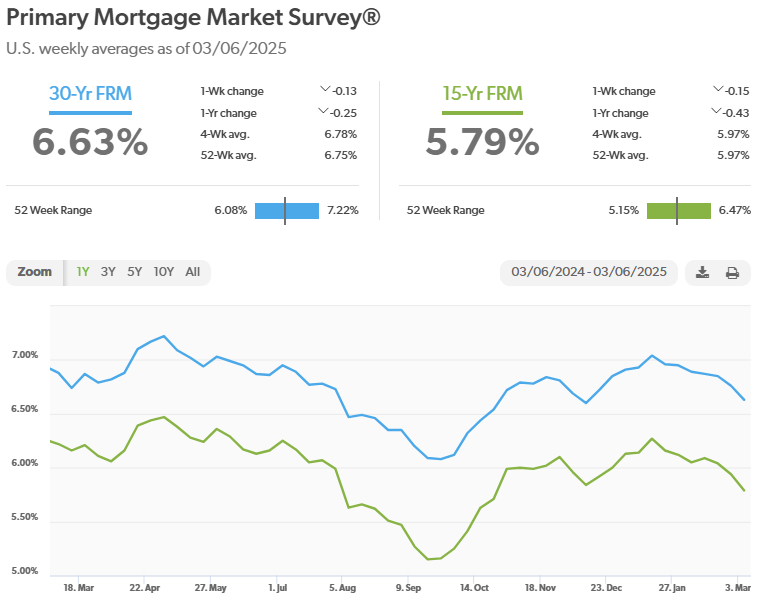
Freddie Mac was chartered by Congress in 1970 to keep money flowing to mortgage lenders in support of homeownership and rental housing. Their mandate is to provide liquidity, stability, and affordability to the U.S.
Economic Update | Month Ending February 28, 2025
| The economy – February marked some data driven changes in investor and consumer confidence. Since the election stock markets have risen steadily as investors felt that lower tax rates and less regulation would boost the economy and increase corporate profits. The economy has picked up. Stock markets reached historic highs, consumer confidence jumped, job creation has surged, and inflation picked up. For whatever reason, the economy has begun to show signs of slowing down in the last two weeks. On February 14 the January retail sales report was released. Retail sales dropped unexpectedly in January. On January 21, the most recent consumer confidence report showed that consumer confidence dropped significantly. On February 27 new unemployment claims jumped. Stock markets that reached historic highs in January have dropped sharply over the last two weeks and mortgage and bond rates have dropped as well.
Inflation – In August and September 2024 it appeared that the economy was slowing, and that inflation had come under control. The Consumer Price Index (CPI) had steadily worked its way down from its peak of 9.1% in June of 2022 to 2.4% in September 2024. It appeared that the Fed’s campaign to curb inflation had worked. Unfortunately, since the election the economy has picked up and the CPI rate has worked its way up. The latest reading showed that consumer prices were 3% higher in January than they were one year earlier. The Producer Price Index (PPI) has also increased. It measures wholesale prices that are often passed along to consumers. The latest PPI reading showed a 3.5% year-over-year increase. Its highest rate on 18 months. On Friday, February 28, 2025, the government released the Personal Expenditure Index (PPE), the Fed’s preferred measure of inflation. It showed that personal expenditures rose 2.5% year-over-year in January, down from 2.6% in December. That was another surprise. Experts excepted an increase after the CPI, and PPI had jumped. The graph below shows the CPI rate since 2021
Jobs – In 2023 and early 2024 the unemployment rate had ticked along at about 2.6%, its lowest rate since the 1960’s. There were many more jobs available than workers looking for jobs. This created a shortage of workers and wages were rising faster than the Fed was comfortable with. More people working and higher wages increase consumer spending which puts upward pressure on inflation. By August the unemployment rate had jumped to 4.2%. That is still considered full employment, but the shortage of workers had begun to level out. Wages had moderated and were rising at a healthy level. In recent months, the unemployment rate has begun to drop. It’s now at 4% and the shortage of workers has driven wages to their highest annual increases since early last year. Mortgage Interest rates and Bond yields – In September the 30-year mortgage rate had worked its way down to 6% from nearly 8% at their 2023 peak. We were even seeing days with rate locks under 6%. As described above the economy, stock market and jobs market picked up. The 30-year fixed rate was up to 7% in mid-February. It has dropped to 6.6% in the last ten days as signs of slowing in the economy have begun. The 10-year U.S. Treasury Bond Yield had dropped to 3.6% in September 2024 from 5% one year earlier. As the economy heated back up it increased. It was 4.75% in January but has worked its way back to 4.25% in the past few days. Stock markets – The Dow Jones Industrial Average ended the year at 43,840.91, down 1.6% from 44,544.66 on January 31, 2025. The Dow is up 3% year-to-date. The S&P 500 closed the year at 5,954.50, down 1.4% from 6,040.53 on January 31, 2025. It is up 1.3% year-to-date. The NASDAQ closed at 18,847.28, down 4% from 19,627.44 on January 31, 2025. It is down 2.4% year-to-date. U.S. Treasury Bond Yields increased in 2024 – The 10-year U.S. treasury bond yield closed the year at 4.24%, down from 4.58% On December 31, 2024. The 30-year treasury yield ended the year at 4.51%, down from 4.83% on January 31, 2025. We watch bond yields because mortgage rates often follow treasury bond yields. Mortgage rates – Every Thursday Freddie Mac publishes interest rates based on a survey of mortgage lenders throughout the week. The Freddie Mac Primary Mortgage Survey reported that mortgage rates for the most popular loan products as of January 30, 2025, were as follows: The 30-year fixed mortgage rate was 6.76%, down from 6.95% last month. The 15-year fixed was 5.94%, down from 6.12% last month. The graph below shows the trajectory of mortgage rates over the past year
Home sales data is released on the third week of the month for the previous month by the California Association of Realtors and the National Association of Realtors. These are January’s home sales figures. U.S. existing-home sales January 2025 – The National Association of Realtors reported that existing-home sales totaled 4.08-million units on a seasonal annualized rate in January, up 2% from an annualized rate of 4-million units last January. The median price for a home sold in the U.S. in January was $396,900, up 4.8% from $378,600 one year ago. There was a 3.5-month supply of homes for sale in January, up from a 3-month supply one year ago. First-time buyers accounted for 28% of all sales. Investors and second-home purchases accounted for 17% of all sales. All cash purchases accounted for 29% of all sales. Foreclosures and short sales accounted for 3% of all sales. California existing-home sales – The California Association of Realtors reported that existing-home sales totaled 254,110 on an annualized basis in January, down 1.9% from a revised 259,160 homes sold on an annualized basis last January. The statewide median price paid for a home was $838,850 in January, up 6.3% from $789,480 one year ago. There was a 4.1-month supply of homes for sale in January, up significantly from a 2.7-month supply of homes for sale in December and up from a 3.2-month supply in January 2024. The graph below lists home sales data by county in Southern California
|
Economic Update | Week Ending March 1, 2025
| Reports released this week showed that jobless claims had picked up. This points to confirm other reports like a sudden drop in retail sales and consumer confidence that suggest the economy is slowing. On Friday, experts were surprised to learn that the Personal Consumption Expenditure Index (PCE) in January showed just a 2.5% annual increase, down from a 2.6% annual increase in December. That marked the first inflation report in several months that did not show inflation increasing. Mortgage rates and bond yields have dropped in the last two weeks.
Stock markets – The Dow Jones Industrial Average closed the week at 43,840.91, up 1% from 43,428.02 last week. It is up 3% year-to-date. The S&P 500 closed the week at 5,954.50, down 1% from 6,013.13 last week. The S&P is up 1.3% year-to-date. The Nasdaq closed the week at 18,847.28, down 3.5% from 19,524.01 last week. It is down 2.4% year-to-date. U.S. Treasury bond yields – The 10-year treasury bond closed the week yielding 4.24%, down from 4.42% last week. The 30-year treasury bond yield ended the week at 4.51%, down from 4.67% last week. We watch bond yields because mortgage rates follow bond yields. Mortgage rates – Every Thursday Freddie Mac publishes interest rates based on a survey of mortgage lenders throughout the week. The Freddie Mac Primary Mortgage Survey reported that mortgage rates for the most popular loan products as of February 27, 2025, were as follows: The 30-year fixed mortgage rate was 6.76%, down from 6.85% last week. The 15-year fixed was 5.94%, down from 6.04% last week. The graph below shows the trajectory of mortgage rates over the past year
Freddie Mac was chartered by Congress in 1970 to keep money flowing to mortgage lenders in support of homeownership and rental housing. Their mandate is to provide liquidity, stability, and affordability to the U.S. Have a Great Weekend! |
Mortgage Rate Update | February 27, 2025
Mortgage rates – Every Thursday Freddie Mac publishes interest rates based on a survey of mortgage lenders throughout the week. The Freddie Mac Primary Mortgage Survey reported that mortgage rates for the most popular loan products as of February 27, 2025, were as follows:
The 30-year fixed mortgage rate was 6.76%, down from 6.85% last week. The 15-year fixed was 5.94%, down from 6.04% last week.
The graph below shows the trajectory of mortgage rates over the past year.

Freddie Mac was chartered by Congress in 1970 to keep money flowing to mortgage lenders in support of homeownership and rental housing. Their mandate is to provide liquidity, stability, and affordability to the U.S.
Economic Update | Week Ending February 22, 2025
| Stock markets sold off on Friday as new data suggested that the economy was slowing, while inflation was rising. A slowing economy causes inflation to drop, but that has not been the case according to recent data. In the late 1970’s economists had to come up with the term stagflation because the economy was stagnant, and inflation was rising. That’s something that had never happened before. Investors fear that we may be heading into a period like that, but it’s too early to tell. The University of Michigan consumer sentiment index fell to 64.7 in February, a decline of almost 10%. This shocked experts and stock markets dropped sharply with the Dow dropping 700 points, its worst day of 2025. Last Friday it was reported that retail sales unexpectedly fell in January, and retail stocks dropped this week as Walmart forecasted that future sales would be weaker than expected. Often inflation data runs a couple of months behind economic data. The economy has been very strong until these recent reports. Stock markets have increased sharply since the election last November as investors expect lower tax rates and less regulation. Tariffs are another concern, but it is quite probable that if the economy does cool consumers will stop spending and inflation rates will drop. Thinking otherwise is very premature.
Stock markets – The Dow Jones Industrial Average closed the week at 43,428.02, down 2.5% from 44,546.08 last week. It is up 2.1% year-to-date. The S&P 500 closed the week at 6,013.13, down 1.7% from 6,114.63 last week. The S&P is up 2.2% year-to-date. The Nasdaq closed the week at 19,524.01, down 2.5% from 20,026.77 last week. It is up 1.1% year-to-date. U.S. Treasury bond yields – The 10-year treasury bond closed the week yielding 4.42%, down from 4.47% last week. The 30-year treasury bond yield ended the week at 4.67%, down slightly from 4.69% last week. We watch bond yields because mortgage rates follow bond yields. Mortgage rates – Every Thursday Freddie Mac publishes interest rates based on a survey of mortgage lenders throughout the week. The Freddie Mac Primary Mortgage Survey reported that mortgage rates for the most popular loan products as of February 20, 2025, were as follows: The 30-year fixed mortgage rate was 6.85%, down slightly from 6.87% last week. The 15-year fixed was 6.04%, down slightly from 6.09% last week. The graph below shows the trajectory of mortgage rates over the past year
Home sales data is released on the third week of the month for the previous month by the California Association of Realtors and the National Association of Realtors. These are January’s home sales figures. U.S. existing-home sales January 2025 – The National Association of Realtors reported that existing-home sales totaled 4.08 million units on a seasonally annualized rate in January, up 2% from an annualized rate of 4 million units last January. The median price for a home sold in the U.S. in January was $396,900, up 4.8% from $378,600 one year ago. There was a 3.5-month supply of homes for sale in January, up from a 3-month supply one year ago. First-time buyers accounted for 28 % of all sales. Investors and second-home purchases accounted for 17% of all sales. All cash purchases accounted for 29% of all sales. Foreclosures and short sales accounted for 3% of all sales. California existing-home sales – The California Association of Realtors reported that existing-home sales totaled 254,110 on an annualized basis in January, down 1.9% from a revised 259,160 homes sold on an annualized basis last January. The statewide median price paid for a home in was $838,850 in January, up 6.3% from $789,480 one year ago. There was a 4.1-month supply of homes for sale in January, up significantly from a 2.7-month supply of homes for sale in December and up from a 3.2-month supply in January 2024. The graph below lists home sales data by county in Southern California
Have a Great Weekend! |
